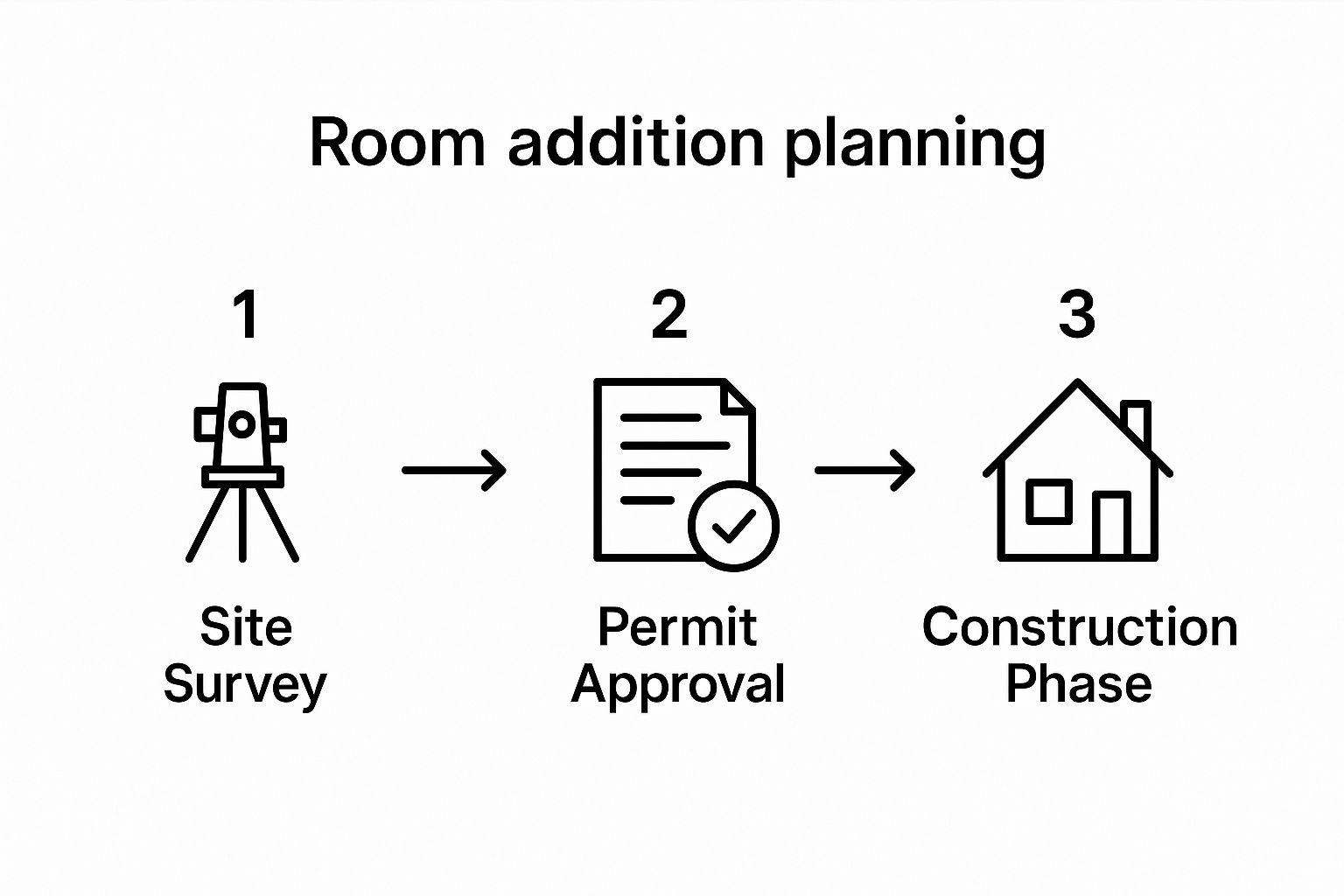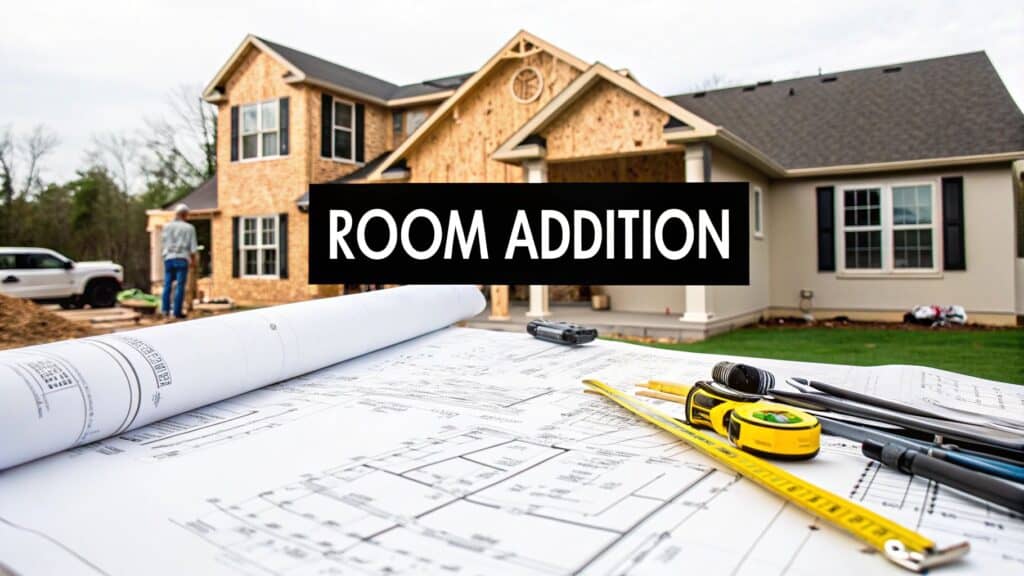Embarking on a room addition is one of the most transformative investments you can make in your Orange County home. Whether you envision a new master suite, a sun-drenched family room, or a dedicated home office, a well-executed addition can completely redefine how you experience your living space. But before you get lost in paint swatches and flooring samples, the success of your entire project rests on this first phase: meticulous room addition planning. It’s the foundational work that turns chaos into calm.
Starting Your Orange County Room Addition
Before a single wall comes down, your vision must be grounded in reality. This means taking an honest look at your core needs, your budget, and the practical constraints of your property. While it may be the less glamorous part of the project, getting this right is what separates a smooth, successful build from a stressful, costly ordeal.

The desire to improve and personalize our homes is a powerful force. The global home remodeling market, which includes additions, was valued at around USD 950 billion in 2023 and is projected to continue growing. For affluent homeowners in Orange County, this isn’t just about adding square footage; it’s about elevating lifestyle, enhancing functionality, and increasing property value.
To help you start on the right foot, here’s a checklist covering the essential first steps for your room addition planning.
Initial Room Addition Planning Checklist
| Planning Area | Key Questions to Answer | Why It Matters |
|---|---|---|
| Project Purpose | Why do I need this space? What problem is it solving? | A clear purpose defines the project scope, from layout to finishes, and prevents costly scope creep. |
| Property Assessment | Where can I build? What are my local setback and lot coverage limits? | Ensures your plans are realistic and compliant with Orange County regulations, avoiding expensive redesigns. |
| Initial Budget | What is my all-in budget, including a 15-20% contingency fund? | A realistic budget guides every decision, protects your investment, and prevents financial strain. |
| Must-Haves vs. Nice-to-Haves | What features are non-negotiable? What can I live without if needed? | Helps prioritize spending and allows for smart, strategic decisions if the budget becomes tight. |
Thinking through these questions early on will provide you and your design-build partner with a clear, actionable roadmap for the entire project.
Defining the Purpose of Your New Space
The most successful additions begin with a simple but critical question: Why do you need more space? The answer will shape every subsequent decision, from the room’s size and layout to the placement of windows and electrical outlets.
- Growing Family Needs: A new baby or the need for a dedicated playroom will prioritize safety, durable materials, and an open, flexible layout.
- Lifestyle Enhancements: Dreaming of a gourmet kitchen extension for hosting? Or perhaps a private home gym or an indoor-outdoor living area to embrace the Southern California climate? The function dictates the design.
- Multi-Generational Living: Designing an in-law suite or an Accessory Dwelling Unit (ADU) requires special consideration. You’ll need to plan for privacy, accessibility features like wider doorways or zero-threshold showers, and potentially a separate entrance.
A room addition should solve a problem. Whether it’s a lack of functional workspace or a need for a private retreat, identifying this core purpose ensures your investment delivers true value, not just extra square footage.
Assessing Your Property and Local Regulations
Once you know what you want to build, it’s time to determine where and how it can fit on your property. In Orange County, this means navigating local zoning laws, which can vary significantly between cities like Irvine, Newport Beach, and Laguna Niguel.
As a licensed General Contractor, Sparkle provides a professional assessment that examines key constraints:
- Setback Requirements: These rules dictate how close your addition can be to your property lines.
- Lot Coverage Limits: Most cities limit the total percentage of your lot that can be covered by structures.
- Height Restrictions: There will be a cap on how tall your addition can be.
- Easements: Your property might have utility easements that you cannot build on.
Clarifying these details early saves significant headaches and redesign costs. The process of expanding your living area shares many principles with other major projects; for instance, the same strategic planning applies when exploring tips for creating a luxurious finished basement. Both require a smart approach to maximizing space and function within your home’s existing footprint.
By aligning your vision with these practical realities from day one, you set your project on the path to success. This foundational work, especially when guided by an experienced partner like Sparkle, is what turns the potential chaos of construction into a calm, predictable process.
Creating a Realistic Budget for Your Addition
Now, let’s discuss the numbers. In the world of room addition planning, developing a realistic, comprehensive budget is the single most important step you can take. It’s the bridge between your vision and your financial reality. Here in Orange County, where costs can vary widely from Irvine to Newport Beach, a solid budget is your best defense against stress and ensures your project rests on a firm financial foundation.
Your first move should be to look beyond a simple “cost per square foot” estimate. While it can offer a rough ballpark figure, that number doesn’t tell the whole story. It ignores the specific details that truly drive the final price tag. A high-end kitchen addition with custom cabinetry and Sub-Zero appliances will exist in a completely different financial realm than a simple bedroom bump-out with standard finishes.
Deconstructing the Costs: Where Your Money Really Goes
To build a budget you can count on, you must understand all its components. A common mistake we see homeowners make is focusing only on the visible elements—like flooring and fixtures—while underestimating the significant costs hidden behind the drywall.
A professional, transparent budget has several core parts:
- Soft Costs (10-15%): These are the expenses incurred before construction begins. This includes fees for your architect and structural engineer, any required soil reports, and the building permit fees from your local Orange County city.
- Hard Costs (75-85%): This is the largest portion of your budget. It covers all labor and materials, including the foundation, framing, roofing, electrical, plumbing, HVAC, insulation, drywall, and all interior and exterior finishes.
- Finishes & Fixtures (Variable): This is where your personal taste can significantly impact the budget. High-end Italian tile, custom-milled cabinetry, and designer lighting will have a much larger effect on the bottom line than standard, builder-grade options.
A critical—and we mean critical—component of your budget is the contingency fund. At Sparkle, we always advise our clients to set aside 15-20% of their total construction budget for the unexpected. This isn’t a slush fund for upgrades. It’s your safety net for discovering unforeseen issues like termite damage or needing to reroute hidden plumbing. It turns a potential crisis into a manageable bump in the road.
Smart Financing Options for Your Home Addition
Once you have a detailed budget, the next question is how you’ll finance it. For most homeowners in Southern California, the answer lies in their home equity. There are several ways to tap into this value, each suited for different financial situations.
Home Equity Line of Credit (HELOC)
A HELOC functions like a credit card secured by your home. You’re approved for a total credit line and can draw funds as needed throughout the project. The primary benefit is that you only pay interest on the amount you’ve used, making it perfect for managing the fluctuating cash flow of a construction project.
Home Equity Loan
This is a more traditional loan where you receive a single lump-sum payment upfront and repay it with fixed monthly installments. The predictability is comforting for many homeowners. However, you begin paying interest on the entire loan amount from day one, even if some funds aren’t needed for months.
Cash-Out Refinance
With this option, you replace your current mortgage with a new, larger one and “cash out” the difference. This can be a smart move if current interest rates are lower than your existing mortgage rate, but it does restart your loan term.
Sometimes, an unexpected event like a fire or major water damage can create an opportunity to remodel or build an addition. In these situations, knowing how to work with your insurance provider is essential. Our detailed guide to navigating property insurance claims can provide invaluable knowledge when blending an insurance-funded restoration with a planned renovation.
Ultimately, this financial planning puts you in control. A transparent budget and the right financing empower you to make informed decisions that protect your investment and bring your vision to life without the chaos of financial surprises.
Navigating Design and Permitting in Orange County
With your budget mapped out, you can now dive into one of the most exciting parts of planning a room addition: the design phase. This is where your ideas transition from concepts to tangible architectural plans. It’s also where creative vision must align with the strict realities of local building codes.

This process is far more than just drawing walls and placing windows. A truly expert designer focuses not only on creating a stunning space but also on ensuring it is structurally sound and integrates seamlessly with your home’s existing character—so it feels like it was always meant to be there.
The demand for such thoughtfully designed spaces is growing. Looking ahead to 2025, remodeling trends show that 17% of homeowners are planning room additions, often to create in-law suites or flexible guest quarters. This is part of a larger trend toward maximizing living space, which also includes kitchen remodels (38%) and bathroom renovations (26%).
The Design-Build Advantage in Southern California
When you’re ready to bring your vision to life, you can hire an architect and then find a separate general contractor, or you can partner with an integrated design-build firm. For discerning homeowners in Orange County, the design-build approach is a game-changer for efficiency, accountability, and peace of mind.
With a design-build firm like Sparkle Restoration Services, the designer and builder are part of the same team from day one. This fosters a collaborative environment where the design is constantly evaluated for buildability and budget alignment. It eliminates the common “finger-pointing” between separate architects and contractors when issues arise, leading to a smoother, more accountable project. Explore our comprehensive remodeling and construction services to see how this integrated method benefits our clients.
Demystifying the Orange County Permitting Process
Once the design is finalized, the next major hurdle is securing the necessary building permits. For many homeowners, this is the most intimidating aspect of room addition planning, especially since regulations vary between cities like Newport Beach, Irvine, and Laguna Niguel.
Let’s be clear: every significant room addition requires a building permit. Attempting to skip this step is a high-stakes gamble that can result in stop-work orders, substantial fines, and even a mandate to tear down the new construction. It is a risk that is never worth taking.
Obtaining a permit involves submitting detailed architectural and structural plans to your local building department for a thorough review. City officials will meticulously check your documents to ensure compliance with:
- California Building Codes (CBC), which cover structural safety, fire resistance, and energy efficiency.
- Local Zoning Ordinances, controlling property line setbacks, building height, and lot coverage.
- Health and Safety Regulations for all electrical, plumbing, and mechanical (HVAC) systems.
This submission and review process can take anywhere from a few weeks to several months, depending on project complexity and the city’s workload. This is precisely where an experienced partner with deep knowledge of each Orange County municipality becomes invaluable. As a firm with local relationships and a thorough understanding of the requirements, we can anticipate red flags, submit a complete package, and efficiently address city requests to keep your project moving forward without costly delays.
Choosing the Right Design Build Partner
The success of your room addition—from initial blueprints to the final walkthrough—hinges on the team you hire. This is the single most important decision you will make. It’s not merely about finding a builder; it’s about entrusting your home, your most significant asset, to a partner who understands your vision and is committed to quality, integrity, and transparency.
In a market like Orange County, your choice of partner will define everything from the level of craftsmanship to your overall peace of mind.
Design Build Firm vs. Traditional Hires
The traditional method involves hiring an architect to create plans and then separately bidding those plans out to general contractors. This approach can work, but it often creates a disconnect. Design and construction exist in separate silos, and when challenges arise, it can devolve into a frustrating game of finger-pointing, with you caught in the middle.
A modern design-build firm offers a single, streamlined solution. The designer, architect, and construction manager are all on the same team, collaborating from day one.
- Unified Accountability: One firm is responsible for the entire project. There’s no confusion and no blame-shifting.
- Seamless Communication: Because the design and construction teams are in constant collaboration, they can identify potential issues long before they become expensive problems on the job site.
- Budgetary Alignment: The builders provide real-time cost feedback during the design phase, ensuring the plans remain grounded in your budget from the start.
This integrated model is the cornerstone of our operations at Sparkle. To see how this single-source accountability makes a world of difference for our clients, you can explore our full range of award-winning design-build services.
Vetting Your Potential Partners
Once you’ve decided on the design-build approach, it’s time to select the right firm. This requires more than a quick Google search. You’re seeking a partner with a proven track record, impeccable credentials, and a communication style that instills confidence.
Start by creating a shortlist of three or four potential firms in the Orange County area. Then, perform your due diligence.
- Verify Licensing and Insurance: This is non-negotiable. Use the California State License Board (CSLB) website to confirm their General Contractor’s license is active and in good standing. Request certificates of insurance to verify they carry both general liability and workers’ compensation coverage. This protects you from liability in the event of an on-site accident.
- Scrutinize Their Portfolio: Don’t just glance at the photos. Look for projects similar in scope and style to your vision. Examine the details. Does the finish work—the tile, trim, and paint lines—reflect the high-end result you expect?
- Check Reviews and References: Read online reviews, including our BBB Torch Award-winning profile, but don’t stop there. Ask each firm for a list of recent clients you can speak with directly. This firsthand feedback is invaluable.
When you call a reference, ask specific questions: “How did the team handle unexpected problems?” “Was communication clear and consistent?” and most importantly: “Would you hire them again without hesitation?” The answers will tell you far more than a dozen five-star ratings.
Comparing Bids and Making the Final Choice
After interviewing your top candidates, you will receive proposals. It’s tempting to focus solely on the bottom-line price, but this is a classic mistake. The cheapest bid is rarely the best value.
A suspiciously low price is often a red flag for a contractor who may cut corners, use inferior materials, or lack the experience to estimate costs accurately.
Instead, compare proposals line by line. A truly professional bid, like those provided by Sparkle, will be highly detailed, breaking down costs for materials, labor, permits, and allowances for fixtures and finishes. A vague, one-page proposal is a warning sign.
Ultimately, you are choosing a relationship, not just a price. Trust your professional judgment. Select the team that communicates clearly, inspires confidence, and feels like a true partner dedicated to bringing your vision to life with excellence.
Managing the Construction Process with Confidence
Once the permits are approved and the team arrives, all your careful room addition planning transitions into active construction. This is where the blueprint becomes reality. It’s also the phase where strong project management separates a chaotic, stressful experience from a calm, controlled build.
The way a firm manages a job site speaks volumes about its professionalism.

Watching your plans transform into a physical structure is incredibly exciting, but it also requires a new level of engagement. Understanding the construction sequence and knowing how to communicate effectively with your project manager is crucial for keeping everything on track and minimizing disruption to your life in your Orange County home.
The Anatomy of a Build Phase
While every project is unique, the construction sequence for a room addition follows a predictable path. Knowing this progression helps you anticipate what’s next and ask more informed questions.
Here’s a typical flow you can expect:
- Site Prep & Foundation: The crew will clear and grade the site, establish protective barriers, and pour the concrete foundation—the literal base for your entire addition.
- Framing: This is when the vision takes shape. The structural skeleton of your new room—walls, floor joists, and roof trusses—is assembled. You’ll finally get a true sense of the space’s volume and layout.
- MEP (Mechanical, Electrical, & Plumbing): Before drywall is installed, licensed tradespeople run all essential systems through the open framing: wiring, plumbing lines, and HVAC ductwork.
- Insulation & Drywall: After the MEP systems pass inspection, high-performance insulation is installed. Then, drywall is hung, taped, and textured, creating the finished interior surfaces.
- Finishes (Exterior & Interior): This is where the design comes to life. Siding, windows, roofing, flooring, paint, cabinetry, and fixtures are all installed, completing the project.
This structured process includes crucial city inspections between major phases, ensuring every aspect is built to code and to the highest standard of quality.
Your project manager is your single point of contact and most valuable asset during construction. We believe a weekly on-site meeting is a non-negotiable best practice. It provides dedicated time to review progress, ask questions, and address any concerns before they can escalate.
Navigating Change Orders and Site Walk-Throughs
Even with the most detailed plans, changes can occur. You might decide an extra window is needed, or the team might uncover an unexpected structural issue. This is managed through a formal change order.
A professional contractor will document any proposed change in writing, clearly outlining its impact on both the budget and the schedule. You must sign off on this document before any new work begins. This process ensures complete transparency and prevents surprise costs at the end of the project.
During your regular site walk-throughs, be an observant partner. Your role isn’t to supervise the crew, but to monitor progress and communicate with your project manager. Two key indicators of a well-run project are cleanliness and safety. A tidy site reflects a high level of professionalism. Also, confirm that the materials being installed are the ones you selected.
Building sustainably is another top priority for Sparkle. With new construction on the rise, it’s alarming that many structures don’t adhere to modern energy codes. By ensuring your addition has proper insulation and energy-efficient windows, you’re not just saving on future utility bills—you’re investing in a more responsible building standard.
At Sparkle, we ensure every addition we build in communities like Newport Beach or Irvine meets and exceeds California’s rigorous energy standards. It’s a core component of our commitment to excellence and long-term value for our clients.
Answering Your Room Addition Questions
Even with a perfect plan, questions are inevitable. It’s natural when you’re making such a significant investment in your home. As a BBB Torch Award-winning firm known for our client-focused approach, we believe in providing clear, authoritative answers. Here are some of the most common questions homeowners in Orange County ask us.
How Long Does a Room Addition Take in Orange County?
For a professionally managed project in Orange County, a realistic timeline is 4 to 12 months. This encompasses the entire process, from our initial design consultation to the final walkthrough.
This timeline is not arbitrary; it’s a sequence of well-defined stages, each requiring dedicated time and expertise.

As you can see, the actual construction is just one piece of a much larger, more complex puzzle. The most critical work begins long before the first shovel hits the ground.
What Is the Average Cost Per Square Foot for a Home Addition?
In affluent areas like Newport Beach and Irvine, a high-quality room addition typically falls in the range of $400 to over $800 per square foot. This is a wide range because the final cost is directly tied to the project’s complexity and the level of finishes.
A simple bedroom expansion is a completely different project than a full second-story master suite with a luxury bathroom, which requires intricate engineering, plumbing, electrical, and high-end finishes. This is why relying solely on a square-foot estimate can be misleading. A detailed, line-item proposal from a trusted contractor is the only way to determine an accurate cost.
Your investment should align with your home’s value and neighborhood standards. The goal is to enhance your property’s overall appeal with matching quality, not just add square footage. This is where a builder with deep local knowledge becomes your most valuable asset.
Can I Live in My House During Construction?
Yes, in most cases, you can absolutely remain in your home during construction. This requires meticulous planning and close coordination. The decision hinges on the project’s scope and its location relative to your main living areas.
- A ground-floor addition that is largely self-contained will have a minimal impact on your daily life.
- A project that involves a core part of your home, like the kitchen, will naturally be more disruptive.
As a client-focused contractor, Sparkle prioritizes your family’s comfort and safety. We develop a comprehensive “livability plan” that includes setting up heavy-duty dust barriers, establishing clear work zones for our IICRC-certified team, and providing a transparent schedule so you are always informed.
How Much Value Does an Addition Add to My Home?
A well-designed and expertly built room addition can offer a strong return on investment (ROI), often recouping 50-70% of its cost at resale. However, in a competitive market like Orange County, the true value extends beyond that number.
It’s about marketability. An addition that adds a highly desirable feature—such as a dedicated home office, a ground-floor master suite for multi-generational living, or an expanded luxury kitchen—can make your home stand out dramatically to prospective buyers. The key is to create a space that feels seamlessly integrated with the original home’s design and quality.
We understand you likely have more questions specific to your project. For more expert answers, please visit our comprehensive FAQs page or contact us to schedule a complimentary consultation.

